Corinella History Trail

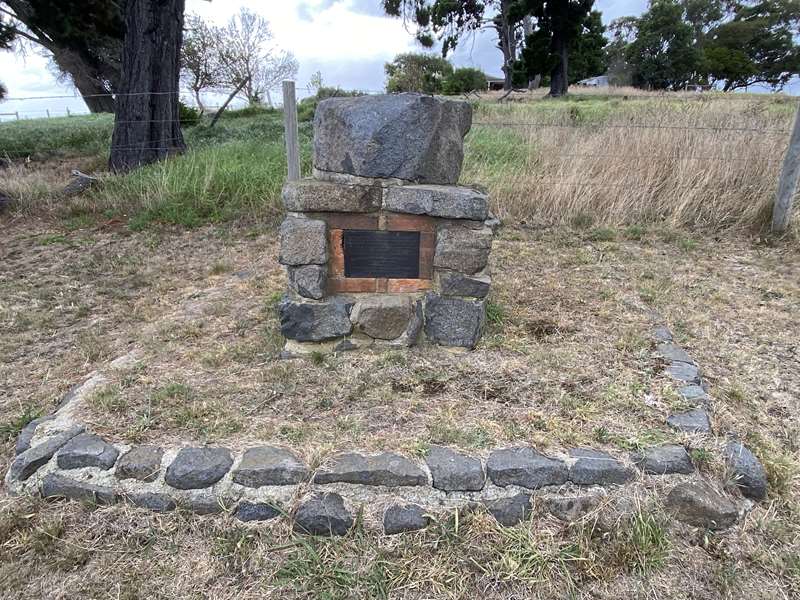
The Corinella History Trail features storyboards on timber pedestals that tell a story of times past at Corinella.
The storyboards are located on the south side of the Harold Hughes Reserve. the storyboards give the visitor a visual description of locations throughout Corinella that were and still are important features of Corinella, it speaks of the people and places and pastime that helped shape Corinella.
This map shows where these events occurred or where places of interest are located.
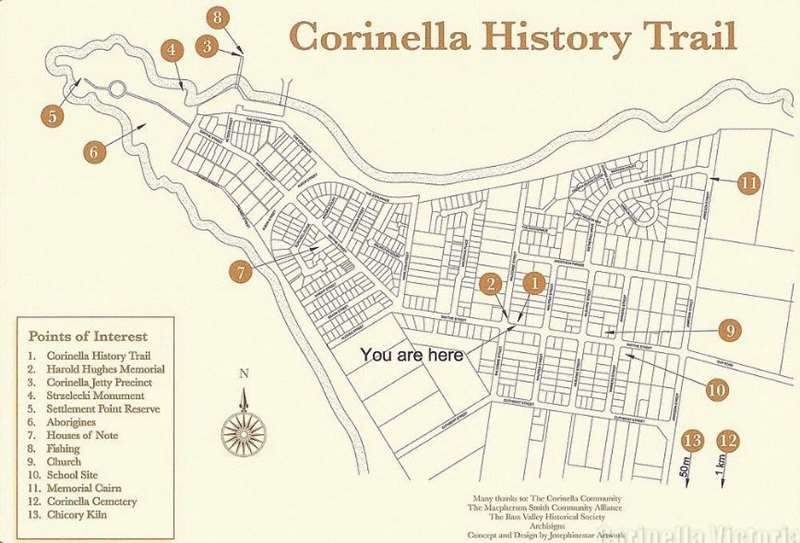
2. Harold Hughes
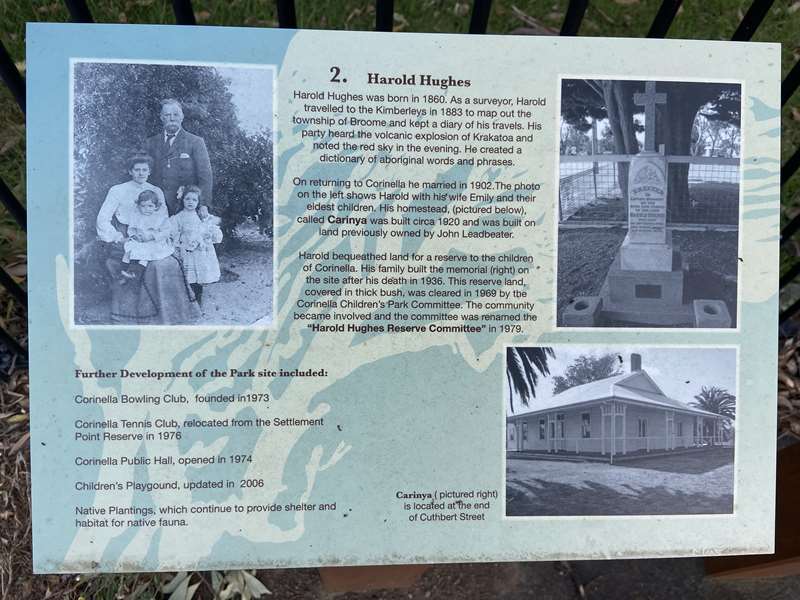
Harold Hughes was born in 1860. As a surveyor. Harold travelled to the Kimberleys in 1883 to map out the township of Broome and kept a diary of his travels. His party heard the volcanic explosion of Krakatoa and noted the red sky in the evening. He created a dictionary of aboriginal words and phrases.
On returning to Corinella he married in 1902. The photo on the left shows Harold with his wife Emily and their eldest children. His homestead, (pictured below), called Carinya was built circa 1920 and was built on land previously owned by John Leadbeater.
Harold bequeathed land for a reserve to the children of Corinella. His family built the memorial (right) on the site after his death in 1936. This reserve land, covered in thick bush, was cleared in 1969 by the Corinella Children's Park Committee. The community became involved and the committee was renamed the "Harold Hughes Reserve Committee" in 1979.
3. Jetty Precinct
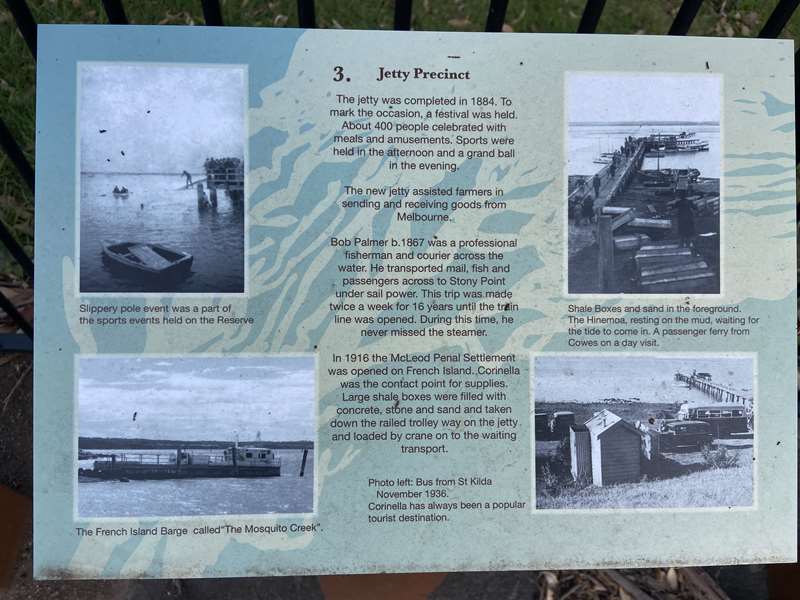
The jetty was completed in 1884. To mark the occasion, a festival was held. About 400 people celebrated with meals and amusements. Sports were held in the afternoon and a grand ball in the evening.
The new jetty assisted farmers in sending and receiving goods from Melbourne.
Bob Palmer b.1867 was a professional fisherman and courier across the water. He transported mail, fish and passengers across to Stony Point under sail power. This trip was made twice a week for 16 years until the train line was opened. During this time, he never missed the steamer.
In 1916 the McLeod Penal Settlement was opened on French Island. Corinella was the contact point for supplies. Large shale boxes were filled with concrete, stone and sand and taken down the railed trolley way on the jetty and loaded by crane on to the waiting transport.
4. Strzelecki
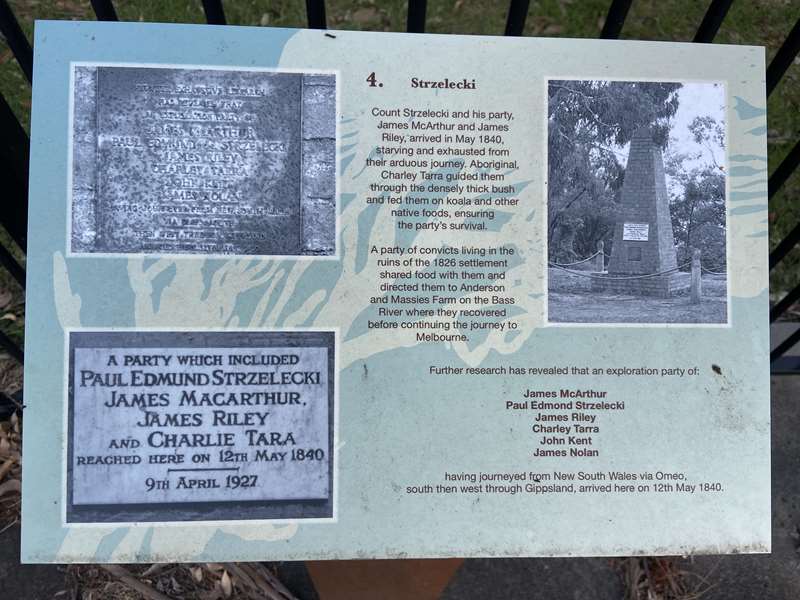
Count Strzelecki and his party, James McArthur and James Riley, arrived in May 1840, starving and exhausted from their arduous journey. Aboriginal, Charley Tarra guided them through the densely thick bush and fed them on koala and other native foods, ensuring the party's survival.
A party of convicts living in the ruins of the 1826 settlement shared food with them and directed them to Anderson and Massies Farm on the Bass River where they recovered before continuing the journey to Melbourne.
Further research has revealed that an exploration party of: James McArthur, Paul Edmond Strzelecki, James Riley, Charley Tarra, John Kent and James Nolan having journeyed from New South Wales via Omeo, south then west through Gippsland, arrived here on 12th May 1840.
5. Settlement Point The Reserve
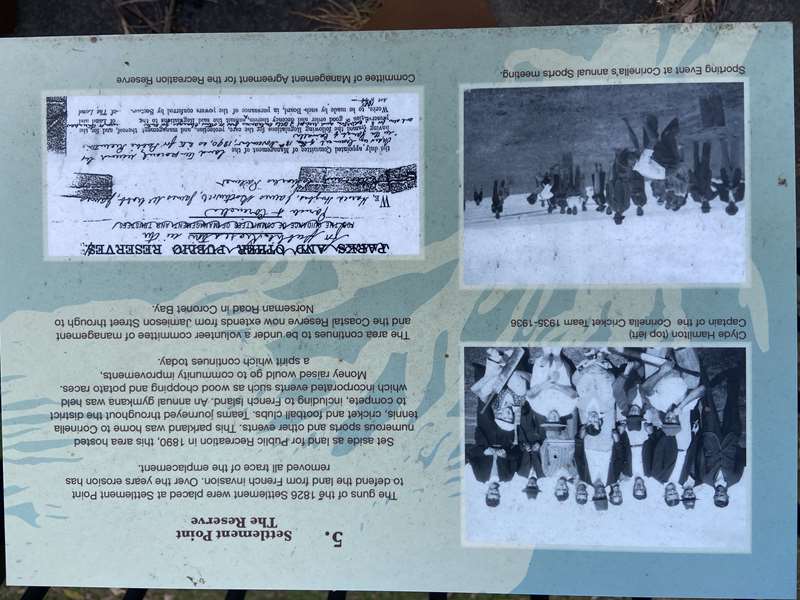
The guns of the 1826 Settlement were placed at Settlement Point to defend the land from French invasion. Over the years erosion has removed all trace of the emplacement.
Set aside as land for Public Recreation in 1890, this area hosted numerous sports and other events. This parkland was home to Corinella tennis, cricket and football clubs. Teams journeyed throughout the district to compete, including to French Island. An annual gymkana was held which incorporated events such as wood chopping and potato races. Money raised would go to community improvements, a spirit which continues today.
The area continues to be under a volunteer committee of management and the Coastal Reserve now extends from Jamieson Street through to Norseman Road in Coronet Bay.
6. Aborigines
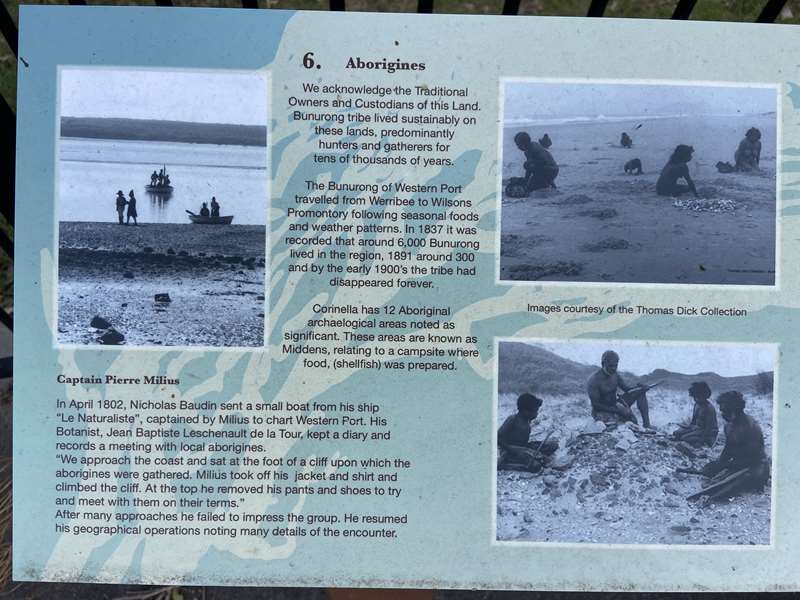
We acknowledge the Traditional Owners and Custodians of this Land. Bunurong tribe lived sustainably on these lands, predominantly hunters and gatherers for tens of thousands of years.
The Bunurong of Western Port travelled from Werribee to Wilsons Promontory following seasonal foods and weather patterns. In 1837 it was recorded that around 6,000 Bunurong lived in the region, 1891 around 300 and by the early 1900's the tribe had disappeared forever.
Corinella has 12 Aboriginal archaeological areas noted as significant. These areas are known as Middens, relating to a campsite where food, (shellfish) was prepared.
Captain Pierre Milius - In April 1802, Nicholas Baudin sent a small boat from his ship "Le Naturaliste", captained by Milius to chart Western Port. His Botanist, Jean Baptiste Leschenault de la Tour, kept a diary and records a meeting with local aborigines.
"We approach the coast and sat at the foot of a cliff upon which the aborigines were gathered. Milius took off his jacket and shirt and climbed the cliff. At the top he removed his pants and shoes to try and meet with them on their terms." After many approaches he failed to impress the group. He resumed his geographical operations noting many details of the encounter.
7. Houses of Note
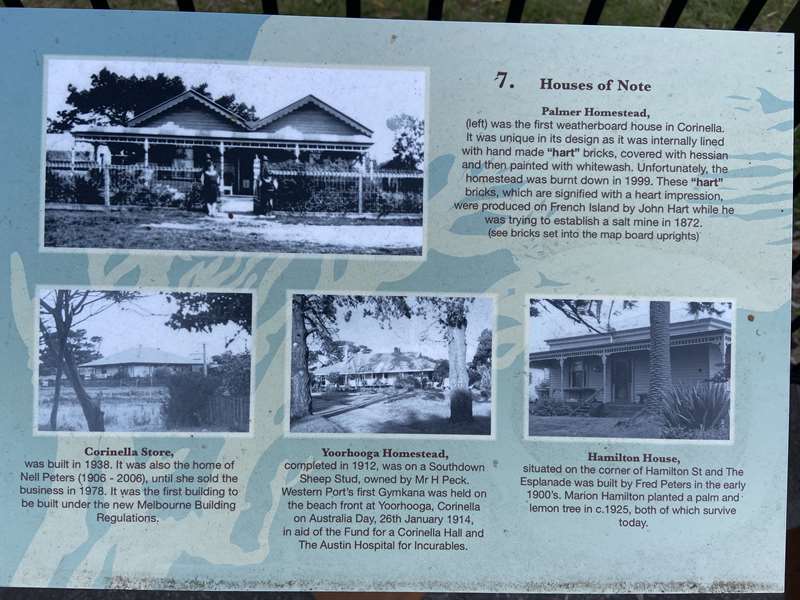
Palmer Homestead, (top left) was the first weatherboard house in Corinella. It was unique in its design as it was internally lined with hand made "hart" bricks, covered with hessian and then painted with whitewash. Unfortunately, the homestead was burnt down in 1999. These "hart" bricks, which are signified with a heart impression, were produced on French Island by John Hart while he was trying to establish a salt mine in 1872. (see bricks set into the map board uprights)
Corinella Store, was built in 1938. It was also the home of Nell Peters (1906 - 2006), until she sold the business in 1978. It was the first building to be built under the new Melbourne Building Regulations.
Yoorhooga Homestead, completed in 1912, was on a Southdown Sheep Stud, owned by Mr H Peck. Western Port's first Gymkana was held on the beach front at Yoorhooga, Corinella on Australia Day, 26th January 1914, in aid of the Fund for a Corinella Hall and The Austin Hospital for Incurables.
Hamilton House, situated on the corner of Hamilton St and The Esplanade was built by Fred Peters in the early 1900's. Marion Hamilton planted a palm and lemon tree in c.1925, both of which survive today.
8. Fishing
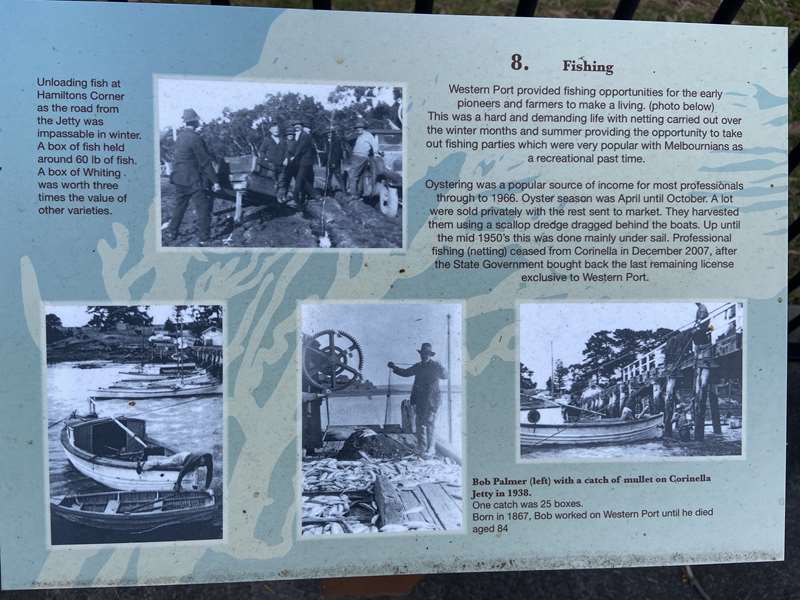
Western Port provided fishing opportunities for the early pioneers and farmers to make a living. This was a hard and demanding life with netting carried out over the winter months and summer providing the opportunity to take out fishing parties which were very popular with Melbournians as a recreational past time.
Oystering was a popular source of income for most professionals through to 1966. Oyster season was April until October. A lot were sold privately with the rest sent to market. They harvested them using a scallop dredge dragged behind the boats. Up until the mid 1950's this was done mainly under sail. Professional fishing (netting) ceased from Corinella in December 2007, after the State Government bought back the last remaining license exclusive to Western Port.
Unloading fish at Hamiltons Corner as the road from the Jetty was impassable in winter. A box of fish held around 60 lb of fish. A box of Whiting was worth three times the value of other varieties.
9. St George's Church of England
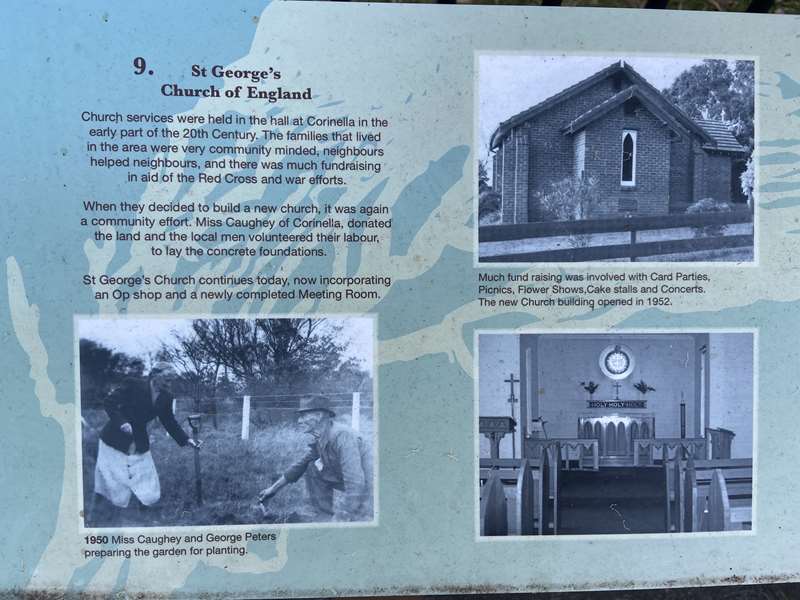
Church services were held in the hall at Corinella in the early part of the 20th Century. The families that lived in the area were very community minded, neighbours helped neighbours, and there was much fundraising in aid of the Red Cross and war efforts.
When they decided to build a new church. it was again a community effort. Miss Caughey of Corinella, donated the land and the local men volunteered their labour, to lay the concrete foundations.
St George's Church continues today, now incorporating an Op shop and a newly completed Meeting Room.
10. Corinella State School
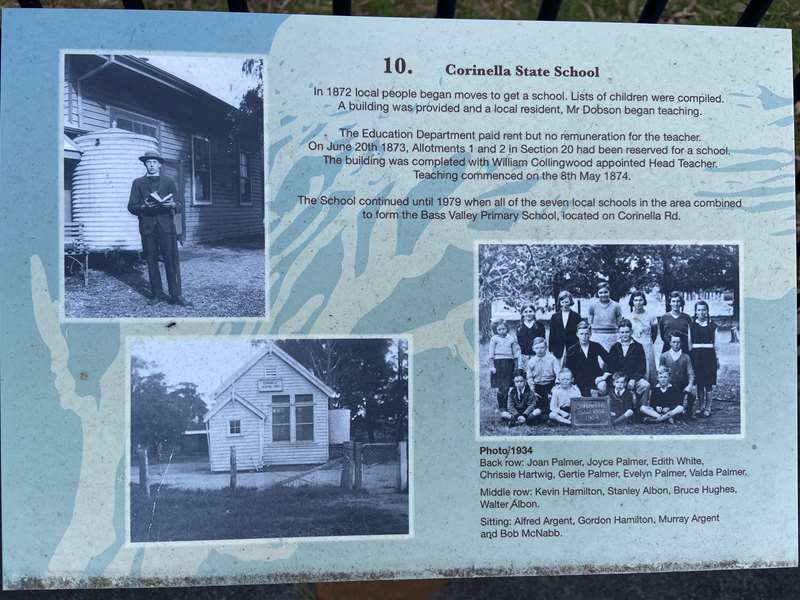
In 1872 local people began moves to get a school. Lists of children were compiled. A building was provided and a local resident, Mr Dobson began teaching.
The Education Department paid rent but no remuneration for the teacher. On June 20th 1873, Allotments 1 and 2 in Section 20 had been reserved for a school. The building was completed with William Collingwood appointed Head Teacher. Teaching commenced on the 8th May 1874.
The School continued until 1979 when all of the seven local schools in the area combined to form the Bass Valley Primary School, located on Corinella Rd.
11. Memorial Cairn
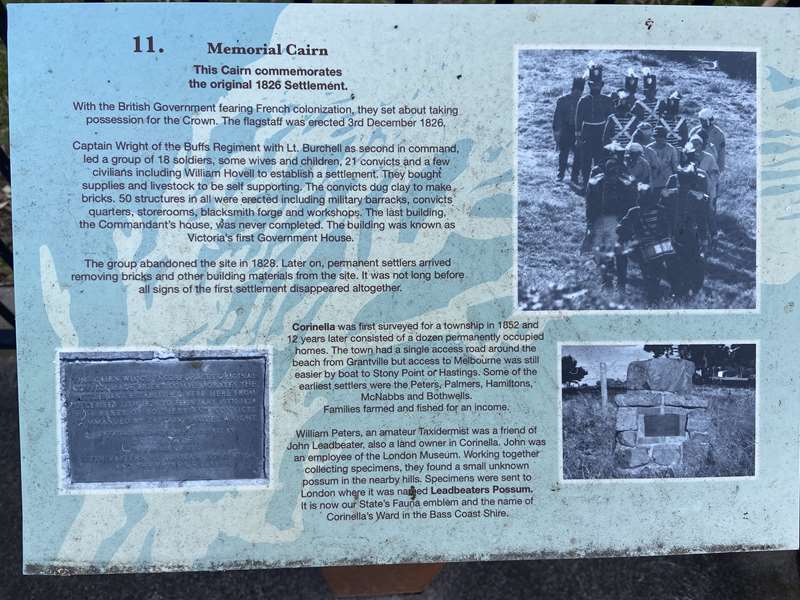
This Cairn commemorates the original 1826 Settlement.
With the British Government fearing French colonization, they set about taking possession for the Crown. The flagstaff was erected 3rd December 1826.
Captain Wright of the Buffs Regiment with Lt. Burchell as second in command, led a group of 18 soldiers, some wives and children, 21 convicts and a few civilians including William Novell to establish a settlement. They bought supplies and livestock to be self supporting. The convicts dug clay to make bricks. 50 structures in all were erected including military barracks, convicts quarters. storerooms, blacksmith forge and workshops. The last building, the Commandant's house, was never completed. The building was known as Victoria's first Government House.
The group abandoned the site in 1828. Later on, permanent settlers arrived removing bricks and other building materials from the site. It was not long before all signs of the first settlement disappeared altogether.
Corinella was first surveyed for a township in 1852 and 12 years later consisted of a dozen permanently occupied homes. The town had a single access road around the beach from Grantville but access to Melbourne was still easier by boat to Stony Point or Hastings. Some of the earliest settlers were the Peters, Palmers. Hamilton, McNabbs and Bothwells. Families farmed and fished for an income.
William Peters, an amateur Taxidermist was a friend of John Leadbeater, also a land owner in Corinella. John was an employee of the London Museum. Working together collecting specimens, they found a small unknown possum in the nearby hills. Specimens were sent to London where it was named Leadbeaters Possum. It Is now our State's Fauna emblem and the name of Corinella's Ward in the Bass Coast Shire.
12. Corinella Cemetery
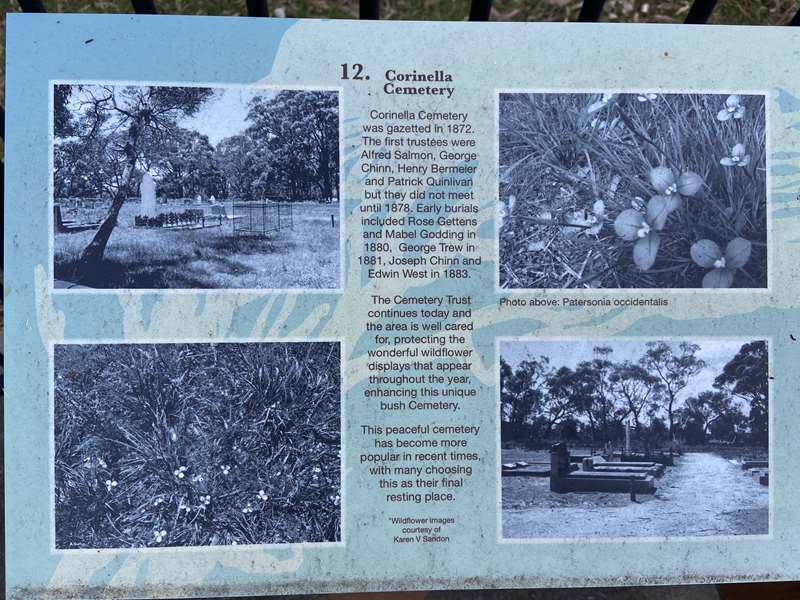
Corinella Cemetery was gazetted in 1872. The first trustees were Alfred Salmon, George Chinn, Henry Bermeier and Patrick Quinlivan but they did not meet until 1878. Early burials included Rose Gettens and Mabel Godding in 1880. George Trew in 1881, Joseph Chinn and Edwin West in 1883.
The Cemetery Trust continues today and the area is well cared for, protecting the wonderful wildflower displays that appear throughout the year, enhancing this unique bush Cemetery. This peaceful cemetery has become more popular in recent times, with many choosing this as their final resting place.
13. Chicory
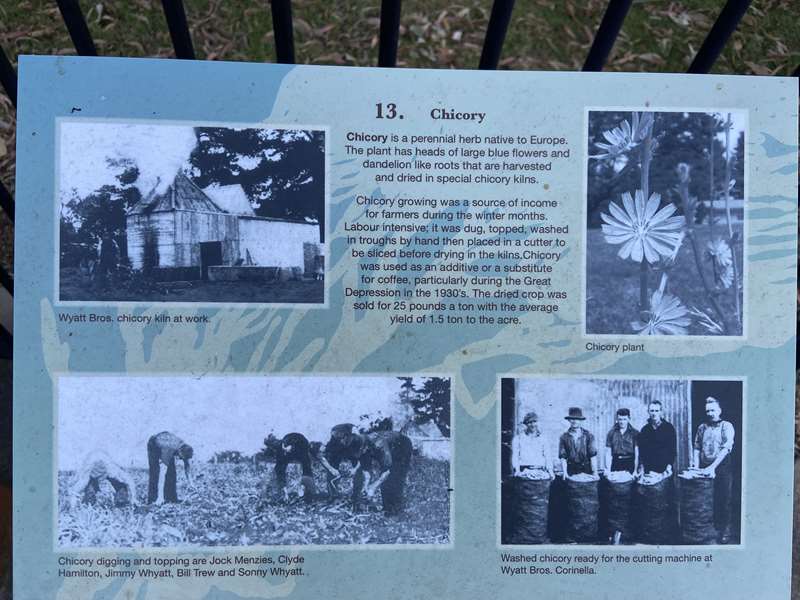
Chicory is a perennial herb native to Europe. The plant has heads of large blue flowers and dandelion like roots that are harvested and dried in special chicory kilns.
Chicory growing was a source of income for farmers during the winter months. Labour intensive; it was dug, topped, washed in troughs by hand then placed in a cutter to be sliced before drying in the kilns. Chicory was used as an additive or a substitute for coffee, particularly during the Great Depression in the 1930's. The dried crop was sold for 25 pounds a ton with the average yield of 1.5 ton to the acre.
Photos:
Location
19 Balcombe Street, Corinella 3984 View Map
Web Links
→ Corinella History Trail








